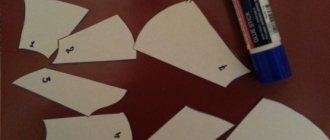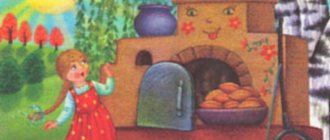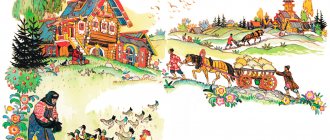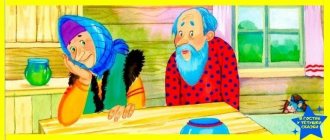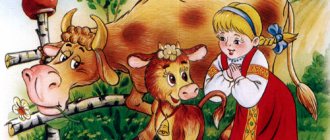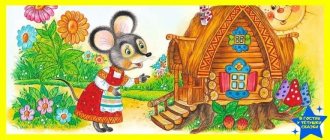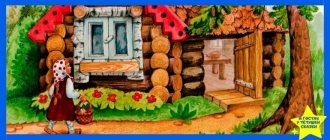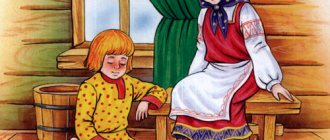Although games in Rus' have always been considered fun, our ancestors attached great educational importance to them. Where else, if not in a game, does a child learn about the world, relationships between peers, relationships between elders and younger ones, learn to follow the rules and obey them.
Nowadays everyone knows that play is the basis of a child’s life. Psychologists say that through it the baby receives the necessary knowledge and skills. Thanks to the game, he develops as a person and acquires social skills. Everyone understands this very well, but often parents do not find the opportunity to actively play with their children. A lot of interesting children's entertainment has been replaced by a computer. Unfortunately, psychologists have recorded the fact that the influence of play on a child’s personality is weakening for various reasons.
The usefulness of folk games
Caring parents, aware of their busyness and inability to fully communicate with their child, try to surround him with a variety of toys. This is good, since the baby should have the opportunity to explore the world around him through the toy. But, more often than not, everything ends with the purchase of toys because adults consider their mission completed. Meanwhile, for a preschooler to play, he must be taught to do so. When a baby can play independently, then he will not need a large number of toys.
What are the best games to offer to children? How to find a game that will unite an adult and a child? Russian folk games will help solve these questions. They have been selected for centuries, and the most beloved and popular ones have come down to us, which are easy to organize in any setting: on vacation, at home. The time has come for modern parents to find out what games their great-grandfathers played and how they are useful for our children.
Holiday fun
Even in ancient times, folk games were united into different groups. They differed in purpose, number of participants, complexity of the rules, and age of the children. However, most folk games are so unique that each of them, according to its characteristics, can be included in any group.
For ease of use, you can divide all games into holiday and everyday ones. Festive folk games for preschoolers are good because they bring a lot of fun and entertainment to the participants. Preschoolers enjoy the gameplay itself, the opportunity to communicate with peers or older children without any conventions.
Such entertainment contains a minimum number of simple rules that are easy to follow, so they are great for various types of celebrations when many children gather: birthdays, family celebrations, holiday events.
Russian folk games for children are easy to participate in, since they contain simple plots, familiar characters act there, and the rules are clear and accessible to children. All this arouses interest among preschoolers and a desire to take part in a common game.
In addition, in the age of computers, when there is a lot of talk about poor posture in children, a sedentary lifestyle that causes all sorts of diseases, folk games are an excellent opportunity to encourage children to move, to develop in them such qualities as ingenuity, dexterity, dexterity, and resourcefulness. Another positive side of such entertainment is that children of different ages can participate there, from toddlers to high school students.
What interesting games should you offer children?
Preschoolers and children can take part in the universal fun “Rooster Fight”, “Cockerels and Hens”, “Ducks and Geese”, “Trap with a Goat”, “Bear in the Forest”, which reflect the living world in their themes and imitate the habits of animals older guys. Everyone loves games that give them the opportunity to run wild and show off their resourcefulness. They actively develop motor skills and acquire new skills.
Game "Cock Fight"
In the fun “Cock Fight,” the players, with their legs tucked in, trying to maintain balance, push each other with their shoulders.
The winner is the player who forces his opponent to his feet.
Game "Cockerels and Hens"
The fun “Cockerels and Hens” is a pair game, which allows the child to feel responsible for his peer. Teaming up in twos, over a certain period of time, players collect large seeds (for example, pumpkins) scattered on the ground.
The winners are the players who collect the most beans.
You can also look at old-time running entertainment.
Game "Bear in the Forest"
The fun “A Bear in the Forest” is a classic of the genre, well known to both big and small, and has firmly entered the curriculum of preschool institutions. To play the game, two lines are drawn on opposite sides of the court. One has a driver, imitating a sleeping bear, the other has the rest. The adult gives a signal, and the preschool children slowly, “picking mushrooms and berries,” go to the “bear.” You can't run until all the words have been said. The quatrain accompanying the players’ actions is simple, easy to remember, and therefore pronounced in chorus:
“The bear has mushrooms in the forest, I pick the berries. But the bear is not sleeping, he’s still looking at us! "
The end of the rhyme is a signal to the “bear” who is running after the children. He catches players until they reach his line. Then the child who was caught drives.
For variety, you can use a more complex nursery rhyme:
“I pick mushrooms and berries from a bear in the forest. But the bear is not sleeping, he is still looking at us. And then he growls and runs after us! But we take the berries and don’t give them to the bear. Let's go into the forest with a club and hit the bear in the back! "
Game "Ducks and Geese"
The “Ducks and Geese” entertainment helps children show restraint and dexterity, since according to the rules, they must walk to the goal at a “duck pace.” When playing, participants form a circle with their hands behind their backs. With a ball in his hands, the driver walks in a circle and says the word “duck” several times, then, unexpectedly for everyone, changes the word, saying “goose.” The ball is quickly placed in the hand of one of the players. Then the driver and the child with the ball go left and right, moving towards each other in a circle. Everyone strives to be the first to reach the “empty” place where the movement began. When meeting, the players greet: “Good morning (afternoon, evening)! "
The player who comes first wins. The leader is the one who came last.
Game "Trap - goat"
The outdoor game “Trap - Goat” consists of traditional content and rules that are found in any similar game. As an option, you can use the image of different animals, for example, “Trap is a wolf.” A “goat” is selected, the players say a nursery rhyme: “The little goat is gray, the tail is white, We will give you something to drink, We will feed you, Don’t butt us, But play with the trap.” Having said the quatrains of the nursery rhyme in chorus, the players run away, and the “goat” catches them, trying to “gore” them, imitating the movements of the animal.
Taking into account the age of the kids and their interests, similar games can always be found in different sources.
Games reflecting the relationship between man and nature
Wolves in the Moat
This game is agile and easy. It can be played by both primary and secondary school children.
On the playground, two horizontal lines are drawn in the center, at a distance of 1 m from each other. A driver is chosen from among the children to act as a “wolf.” If the playing place is large, then you can choose two drivers if you wish.
The “wolves” stand in the space between the lines - this is a ditch, and the rest of the children will be “goats” and they stand behind the “wolf” line. On command, the children must jump over the ditch, and the wolves catch (salat) as many “goats” as possible. After 4-5 jumps over the ditch, a new driver is chosen.
The winner is the one who has never been taunted or the wolf who has caught the most sheep.
Wolves and sheep
You can play in the yard or a spacious room. The number of players is not limited.
To play the game, children, by drawing lots, choose one person to play the role of a shepherd and one to play the role of a wolf, the rest of the children will play sheep.
At opposite ends of the playing field, areas 3-4 steps wide are allocated, which will serve as “pen”.
On one side of the field, a small place is set aside for the wolf and a line is drawn there. The sheep are always in the fold, the shepherd stays close to the flock. As soon as the wolf shouts to the shepherd: “Drive the sheep!”, the shepherd lets his lambs through so that they have time to run to the opposite side of the pen. At the moment when the children are running across the field, a wolf runs out to meet them and begins to kill everyone. The shepherd can interfere with him and try to protect his sheep.
After everyone has run and hid in the corral, those sheep that were molested must go to the wolf and help him catch the next sheep. The winner is the one who has never been caught, and the wolf who, after five races, has caught the most sheep.
Note:
1. Caught sheep have no right to refuse help to the wolf;
2. The wolf does not leave the lair until the sheep leave the fold;
3. Sheep that help the wolf run holding hands, uniting in one large chain.
Lame fox
To play this game you will need a playing area on which you can draw a fairly large circle. Using a counting rhyme, children choose a driver who will play the role of a “lame fox.” After this, the children stand in a circle drawn for them, and outside it there is a fox. At the fox’s command, the children begin to run in a circle past the fox and try not to fall into its “paws.” Meanwhile, the driver must try to grab at least one, and he does this by jumping on one leg. As soon as the “lame fox” insults someone, it quickly runs into the circle, and the one touched becomes the leader.
The game lasts until all the children are in the role of a fox.
Notes:
1. The fox has no right to run on two legs;
2. The fox cannot run into the circle in order to show off;
3. Children should not stand still or in the center of the playground.
Bear and leader
For this game you will need a platform and a rope. The number of players is not limited. One bear and one leader are chosen from among the participants. They grab opposite ends of the rope and the game begins. Children, being at a distance of 4-6 steps, should run up and insult the bear. The leader should not allow this, and tries to protect the bear, and also fires at the attackers.
After the bear is greased 5 times, the leader takes his place, but if he himself greased someone 5 times, then he becomes the leader, and the leader becomes the attacker.
Note:
1. As soon as someone is insulted, he must speak loudly about it himself;
2. You cannot attack a bear without a command;
3. It is not allowed to unhook your hands from the rope.
Cat and mouse
The number of children playing is not limited. The playing field can be a spacious room or an outdoor area.
Children are divided into two teams: “cats” and “mouse”. Chairs are placed in a circle so that the seats face inward.
“Mice” sit on the chairs provided, and the cats stand behind. Pairs are formed in such a way that one cat does not get the mouse, and she stands behind an empty chair, she will start the game and lead.
The task of the free player is the cat, to wink at one of the children who plays the role of a mouse, and lure him to his free chair. The task of the “cats”, who have their own pair, is to try to keep their player and not lose. If they didn’t have time, then they will have to lure the mice to themselves in the same way. After some time, the players change places.
Note: you cannot hold the “mice” by the shoulders all the time.
Kite and hen
The game will require as many participants as possible, from among whom they choose one hen and a kite.
The kite's task is to catch the chicks, which are protected by the hen.
The chickens line up in a column and hold tightly to each other, and the first chicken to the hen. At this time, the kite walks around and looks for the last chicken, which is what needs to be caught. As soon as he begins to attack, the mother hen must protect her chick, hiss at the offender and block his path in every possible way. When turning, the column of “chicks” should flexibly turn after the hen.
As soon as the kite has caught its prey, the chicken leaves the game, the kite continues its hunt until it catches all the chickens.
After all the chicks have been caught, a new kite is chosen.
Note: the brood hen does not have the right to push the kite away with her hands; If one of the chickens accidentally gets unstuck, then the kite can catch up with it and catch it.
Proteins, nuts and cones
Any number of players can take part in this game. The game can be played on the sports ground, in a spare room, or in a gym.
To carry out the game, you will need 1 presenter, 1 driver and children who will play the role of “squirrels”, “cones” and “nuts”.
The driver says: squirrels-cones-nuts, and the children should stand in groups of three, take each other’s hands and close their circle. After this, they agree among themselves who in their “squirrel’s nest” will be the “squirrel”, “nut” and “cone”. The driver does not have a “nest”, and he must get it.
When the leader says: “Squirrels,” those children whose role is named rush to run from their nests to the next one, changing places with the neighboring squirrel. The most important thing is to have time to take a place for yourself, because the driver is aiming to get a place in someone else’s nest. If someone did not have time to find shelter for themselves, and the driver took someone else’s place, then the “squirrel” becomes the driver and will look for a place for itself as soon as the next command is pronounced.
Swan geese
It is best to play this game on a spacious area, where there is some kind of shelter (trees, benches, playhouses, etc.). The number of children is not limited; it is most interesting to play when there are more than 10-12 people. Among the participants, they choose one leader, 1-2 wolves, the rest of the children will pretend to be geese.
Progress of the game: wolves are hiding behind the trees, and geese are grazing nearby (they cannot see the wolves). The leader is on the opposite side of the geese and gives them the command: “Geese-swans, go home, the wolves are roaming under the mountain!” The children begin to run across the area allotted to them, when suddenly wolves run out and begin to salt them.
After several dashes, the number of geese becomes less and less, and the one who remains the very last wins, and the winner among the wolves is chosen by counting the largest number of geese he has killed.
By the bear in the forest
The game is played on any playground or in the park. The number of children in the game is not limited. On one side of the playing field a line is drawn, which is called the “edge”, and a circle is called the “den”. Among the players, using a counting rhyme, they choose a bear who will sit in the den.
Children walk along the edge of the forest and imitate picking berries and mushrooms. The bear sits in a den and pretends to be sleeping. Children get closer and closer to the bear and sing a song:
I'm walking along the edge of the forest. I'm looking at the bear. I take mushrooms and berries. And I’ll run away from the bear! Teddy bear, clumsy bear. He sat down on the bump with his paw, and Bear roared loudly. And he went to catch the children!
After the last phrase, the bear runs out of its den and tries to catch someone. Anyone who has been touched by a bear must go to his den and sit there. Then the game continues the same way. After the bear has caught all the children, he is replaced by the very first one he caught.
Note: it is not necessary to hold a caught child and drag him into the “den”; he can sit on a bench nearby.
Traditional Russian fun
On holidays, among Russian folk games, entertainment with a large number of participants was popular, when they could divide into groups and compete with each other. From time immemorial, games with a competitive element have been loved by children of different ages, as they provide an opportunity to test their strength, luck, and dexterity. Such traditional Russian games include “Burners”, “Pull the String”, “Chains” and similar ones.
Game "Drag the String"
In the game “Pull the String,” two hoops are placed on the sides of the court. A rope is stretched along the ground so that its ends are in the middle of each hoop. Preschool children are divided into two groups. The participants of each of them, in turn, stand in their hoop, then, at a signal from the driver (an adult or an older child): “One, two, three, run!”, they change hoops, trying to reach the opponent’s place as quickly as possible and pull the rope. The one who completes the actions faster and without errors becomes the winner. Following the first pair, the second runs, then the third, and so on until the end.
The team whose members were faster and pulled the rope more often wins. An adult must participate in this competition to ensure that the rules are followed.
Game "Burners"
In the classic game "Burners", players stand in pairs in a column. Raised hands form a “gate” through which all couples pass. In front of everyone, with his back to the other players, stands the driver, who is also called the “burning one.” The players say the nursery rhyme in chorus: “Burn, burn clearly, So that it doesn’t go out! Look at the sky, Birds are flying, Bells are ringing. Ding-dong, ding-dong, quickly run out! " At the last words, the children in the pair in front scatter in different directions, the rest shout in unison: “One, two, don’t be a crow, but run like fire!” “The driver turns around and catches up with the fleeing children.
If the players manage to take each other’s hands, and the “burning” one is left with nothing, then they again stand behind the column. The driver again catches or “burns” another pair: the game is repeated.
If it is possible to catch one of the fleeing players, then a new pair is formed. The player who is left without a pair becomes the driver.
Game "Chains"
In Chains, players also form two teams. With a little counting table, for example: “A cuckoo walked past the net, And behind it were little children. The cuckoos are asked to drink. Come out - you'll drive! ", select the "breaker" who will break the "chain". The teams are located opposite each other, the participants hold hands tightly. The driver scatters, runs towards the “chain” of opponents, trying to destroy it.
If successful, he takes the opponent to his group; if it doesn’t work out, he himself remains with the opponents. The team with the most players is the winner.
Quite a lot of similar entertainment has been collected and stored in the national treasury. Most of them are relevant and loved today, for example:
- "Geese-geese";
- "Hide and Seek";
- "Cossacks-robbers";
- "Salki";
- "Blind Man's Bluff";
- "Ring".
Others - “Pleten”, “Ringer”, “Lapta” and others are half-forgotten, have more complex rules that need to be memorized with the children first. Every parent can prepare exciting games, fun, and entertainment for children's parties. It all depends on the interest and desire of the adults themselves.
Games that reflect the daily activities of our ancestors
Seine
This gambling game can be played in the summer in any body of water that has shallows. For greatest safety, you need to choose places where there is no strong current. It is better if many people participate in the game, preferably there should be no less than 6-8. All players are divided into two teams - one team will represent the “fishermen”, and the second - the “fish”. Fish can move throughout the entire territory designated for the game. You should not go into the deepest parts of the river. The goal of the fishermen is to catch as many fish as possible. To do this, fishermen join their hands and try to surround the “prey” with a chain resembling a net. Fish can escape in any way - swimming, diving, moving through shallow water. When the fishermen close the circle and narrow it so that the fish have nowhere to go, the teams change places and the game starts over.
According to some rules, fish can only run away until the fishermen close the circle. After this, the fish that did not have time to escape from the circle are considered caught, since it is not allowed to escape by slipping under the hands of the fishermen.
Fishing rod
This game can be played both on the court and on the water. An inflatable ball is wound onto a skipping rope and spun in a circle, the driver says:
I'll put out a fishing rod and catch a lot of fish. I’ll make some delicious fish soup and invite all my best friends.
If they are playing on the playground, then the children must jump over the “fishing rod”. If the game takes place on the water, then the children must have time to dive so that the ball does not touch them.
The last one standing wins.
Bird catcher
You can play on any site. The number of players is not limited.
At the beginning of the game, a driver is selected and blindfolded. Children come up with some kind of bird whose voice they can imitate and disperse around the playground.
In the forest, in the woods, on a green oak tree. The birds are singing merrily, Ay! The bird catcher is coming! He will take us into captivity, Birds, fly away!
After these words, the driver claps his hands, the children freeze, and he tries to find them. As soon as he finds the player, he asks him to identify himself. The found “bird” must pronounce those sounds that are characteristic of it in nature. The driver’s task is to guess what kind of bird is in front of him and who the child is who is portraying it.
Note: “birds” are not allowed to hide behind objects that will block the path of the “catcher”.
Brook
This game is very old, our grandparents loved to play it. She is cheerful and perky.
A driver is chosen from all the participants, and the rest of the girls and boys, holding hands, become pairs, after which they line up in a column and raise their clasped hands up above their heads. The driver must run along the resulting “corridor” to take someone as his partner and take her to the end of the column. The one whose pair is broken goes to the beginning of the stream and runs the same way as the first driver. Gradually the trickle moves.
The more participants, the more interesting this game becomes.
Previously, in Rus', this game was used to get to know a girl or boy you liked, or simply as fun at folk festivals.
Baba Yaga
Baba Yaga is the most common and famous fairy-tale heroine, who must not only be harmful and evil, but also be able to keep herself in good shape.
This game is very fun and funny. You can play it with the whole family during the holidays or organize a relay test at school.
Relay rules: children must line up in columns one after another. The relay race will be carried out with a bucket on your leg and a broom in your hand. After running a given distance, the players return to the team and pass the baton to the next participant. The team whose members complete this task the fastest wins.
Zarya-zarnitsa
The number of players is not limited. Additionally, you will need a ribbon to play. From all the players, a driver is chosen, the rest of the children stand in a circle and say:
Dawn-lightning, Red maiden, Walked across the field, Dropped the keys, Golden keys, Blue ribbons, Entwined rings - She went for water!
The players standing in a circle hold their hands behind their backs, and the driver walks around the circle and chooses someone to put a ribbon on their shoulder. After the driver has chosen a player for the pair, he puts a ribbon on his shoulder, and they both run sharply in different directions in a circle, the one who does not get an empty seat remains to drive.
Grandfather-horn
Before the start of the game, a driver is selected from among the participants, who is considered a “sorcerer”, “grandfather-horn”. At the initial stages of the game, the grandfather-horn sits in a specially designated “house” (a space outlined on the site), and does not show himself in any way. At this time, the remaining players, having divided into two equal groups, move away in opposite directions from the “house” at a distance of about twenty steps and draw or mark a line with a branch - this is where the house of this part of the players is located. Between the houses of both teams and the grandfather-horn there is a “field”.
The game begins with Grandfather Horn saying:
-Who is afraid of me?
Players from both teams run from house to house across the field, teasing the driver and answering him: “No one is afraid!”
The goal of the grandfather horn is to catch one of the players by unexpectedly jumping out of the house. A player who is caught by a sorcerer, sits in his house and is considered bewitched, cannot escape. He can leave the sorcerer's house only with the help of his comrades. While in the house of the horn grandfather, the player can stretch his arms over the line and shout: “Tea, tea, help out!” If one of the players manages to run up to the house of the horn grandfather and touch the enchanted captive with his hand, then he “comes to life” and can run away.
The game ends when Grandpa Horn catches all the players. The one who was caught first in the previous one leads the next race.
Hunters and ducks
The game requires a fairly large open area, in the center of which a mark is made - a large circle is outlined. A ball is used as equipment. As many people as possible should participate in the game, the minimum number is about 8-10. All players are divided into two teams, one of which becomes the “hunters”, and the second - the “ducks”. During the game, the ducks must remain inside the circle, and the hunters must remain outside it. The task of the hunting team is to throw the ball at the “flock of ducks”, trying to hit one of them. The ducks, accordingly, move inside the circle, trying to escape from the “hunter’s bullets.” A duck that is hit by the ball is considered “killed” and leaves the game. Hunters must not step inside the circle, and by doing so they are breaking the rules. The throw of a hunter who steps over the line is not counted. Ducks, on the contrary, should not run out of the circle. For such a violation, the duck leaves the game. A hit with the ball must be direct, without bouncing off the ground or another player, only in this case is it counted. Another rule stipulates that hunters should not aim at the heads of players on the opposing team. If the ball hits the duck's head, the hit does not count.
When all the ducks inside the circle are “killed,” the teams switch places. The winner is the team that knocked out all the ducks faster than the other, or knocked out the most ducks within a predetermined time.
Folk games in the daily life of a preschooler
For everyday leisure, you need to choose games that the child could play on his own, but even in them the gameplay should captivate him. The following activities will help:
Game "Male-Kalechina"
The fun “Malechina-Kalechina” is an ancient game. According to the rules, for the action they take a smooth stick, which they place vertically on the tip of the finger and begin to count: “Male china, how many hours until evening?” One two Three…" . Count until the stick falls. Alternatively, the wand can be placed on the palm, forearm, or knee. When falling, the stick should be caught with the other hand to continue the action.
This game is useful for developing motor skills, dexterity, and perseverance in preschoolers.
Game "Spillkins"
Traditional folk entertainment is “Spillikins”, small wooden sticks or figurines. The player uses two fingers or a special hook to grab a figure without touching the neighboring sticks. The child must be encouraged to strive diligently to choose the figures. Some children lack patience.
This kind of fun develops perseverance and fine motor skills, which is very important for a child.
Game "Fanta"
The famous game “Fanta” is very exciting for preschoolers if they know how to play it. It does not require special space or equipment. Useful for preschool children, as it entertains and helps develop memory, speech, and imagination. An adult can play with a child. The presenter begins: “They sent you a hundred rubles, Buy what you want, Don’t take black, don’t take white, Don’t say no!” The child listens carefully to the questions and tries not to use forbidden words when answering. For example, to the question: “Are you going to the ball? “, you can answer: “I’ll go.” Sample questions and answers could be in the old style: “What dress will you wear? ‒ I’ll wear a beautiful dress”, “Will you go in a carriage? “I’ll go on foot.” Or modern: “Are you going to the bakery? Will you buy bread there? " If a player gets confused, he gives the leader a forfeit (any item), and then at the end of the game he “buys back” it. To “redeem” forfeits, you can invite the preschooler to sing a song, read a poem, or use other exciting tasks.
Game "Hide and Seek"
Children especially love the traditional game “Hide and Seek”, the content and rules of which are well known to everyone. It can be organized outdoors and at home. To keep kids interested, a nursery rhyme is used: “One, two, three, four, five, I start looking. Whoever didn’t hide is not my fault. Whoever stands behind me has three horses to drive.” Then everyone hides, and the leader tries to find him. Choosing another presenter may have several options. For example, the leader can be the participant who was discovered first, or use a counting rhyme.
Rhymes and counting rhymes, which are an integral part of fun, one might say their calling card, help to captivate preschoolers, develop their speech skills and imagination. Therefore, when choosing folk games, it is better to give preference to those with folklore.
From the list of games presented, it is clear that, despite the simplicity in plots, rules, and actions, many educational issues are resolved. When a preschooler learns the rules of the ancient game, he will enjoy playing it. Much depends on the parents, who can captivate the child with folk games.
World Games
Game TALKI (FIT), Russia
At the command of one of the players - tag (tag) - all the others scatter. The task of the tag-driver is to catch up with the one running away and make him look dirty. The salty one becomes the driver. Each new driver raises his hand and shouts: “I’m a tag!” It is not allowed to immediately stain the previous tag. To complicate the game, you can set the following, say, additional rules: you cannot salt someone who manages to fall to the ground, leaning on the palms and toes of outstretched legs; or freeze on one leg, holding the other leg laid back with both hands. And we can agree that the one who touches wooden, iron, stone objects with his hand will be safe from the tag. You can also escape in the “house” - a specially outlined circle, etc. The game becomes even more interesting and a little more difficult if you spot not with your hand, but with a small ball.
Balteni game, Latvia
The number of participants in this game is 5 or more. To play you will need a well-hewn wooden stick. First you need to choose a leader. Then all players should lie face down on the grass, and the leader should throw the stick into the bushes so that the players do not find it right away. On command, everyone lying down jumps up and runs to look for a stick. The one who does it the fastest wins. The winner becomes the host.
Game “WOLF IN RVU”, Russia
This ancient game can be a great way to entertain you during recess in the school yard. A corridor up to one meter wide is drawn on the site. The ditch can also be drawn in a zigzag pattern - narrower in some places, wider in others. In the ditch there are drivers - “wolves” - two, three or more: it’s just as you want. All the other players - the “hares” - try to jump over the ditch and not get stained. If the “hare” is stained, he is eliminated from the game. “Wolves” can stain “hares” only while in the ditch. “Hares” do not run across the ditch, but jump over it. That's all the rules. Come up with options yourself...
Game "Belyak", Belarus
This game can be played by 5 or more people. You can play "Belyak" only in winter. To do this, participants need to roll a large ball (diameter - 1 m) out of snow and stand around it, holding hands. Afterwards, each participant must try to pull someone by the hands into the middle of the circle so that he touches the ball with his body. If there really was a touch, the participant is eliminated from the game. Those remaining join hands again and continue the game. The winner is the one who makes the last opponent touch the ball.
Calabash game! (home), Peru
The players draw circle houses for themselves, and the driver remains “homeless.” Everyone shouts in unison “Kalabasa!” (Go home!) and scatter in their own circles. The “homeless man” turns to one of the players: “Are you selling eggs?” He replies: “I don’t, but maybe he’s selling,” and points to a friend, to whom the “homeless man” goes. In the meantime, the players must change places. If the driver manages to occupy someone else’s house, then he becomes its owner, and the one who remains outside the circle leads.
Running with a Scarf Game, Canada
This game can be played by 10 people or more. First, you need to choose a leader among the players. After this, the players stand in a circle, the leader with a scarf runs around it 2 times, touches someone’s back, puts the scarf behind his back and continues to run. The essence of the game is that the player who was touched by the leader must pick up the handkerchief, overtake the leader and return to his place. In this case he wins. If the player does not have time to overtake the leader, he loses and takes his place.
Game “Give me a handkerchief”, Azerbaijan
Children of primary and secondary school age play, from 6 to 40 people. The game requires two small scarves. The players are divided into two teams of equal numbers and lined up one against the other along opposite sides of the court at a distance of 10 - 15 m from each other. Hands are held behind the back. The selected team captains, having received a handkerchief, walk around the back of their ranks and discreetly put the handkerchiefs in the hands of one of the participants standing in the line, so that the others do not notice to whom the handkerchief was given. Then the leader of the game (leader) says: “Give me a handkerchief!” Those who have the scarves quickly run out and hand them over to the leader, who stands in the middle near the side line. Which of the running out participants is the first to hand over the handkerchief receives 1 point for their team. The team with more points wins. The same player cannot run out twice (that is, the same player should not receive a handkerchief more than once. Without a command from the leader, it is not allowed to run out of the line.
Game "White Stick", Tajikistan
More than 10 people can play White Stick. Participants must choose a leader according to the counting count, divide into 2 equal teams and choose a place for the white stick. Then the leader must quietly hide the wand, and the players must look for it. The one who finds the stick carries it to the chosen place, and at this time the players of the other team try to stop him. The wand can be given to your team members.
Punipuni game, New Zealand
This is a Maori game played by two people. Players stand facing each other at a distance of about 2m. One extends his hand in the direction of the other, and the other, with his eyes closed, tries to find his friend’s hand, reach for it and cross his fingers. At the same time, both should not move.
Game "Bilyasha" *, Republic of Mari El
In books of the last century, this game is mentioned as one of the original Cheremis (Mari) or Turkic games. It is still played by teenagers and young people. The number of participants is from 8 to 30 people. Two parallel lines are drawn at a distance of 4 m from one another. Players are divided into two teams and stand in ranks facing each other behind parallel lines. A player who volunteered from one of the teams, shouting “Bilyashal”, runs to the other team, each member of which extends his right hand forward. The person running up, grabbing someone by the hand, tries to pull the opponent across the court and behind his line. If he pulls him over, he makes him his “prisoner”, placing him behind him. If he doesn’t win, but he himself ends up behind the line of the other team, then he becomes (like a “prisoner”) behind the back of his winner. The player is then sent out by the other team. He also grabs the hand of his opponent, whom he hopes to pull over his line. They especially try to pull over the one who has a “prisoner” in order to free him in case of victory. So the teams take turns sending out their players. The game ends with one team gradually winning over all its opponents. During the game, teams cheer on their players by chanting their names. Rules. 1). For tug-of-war, you can choose any player of the opposing team! no one should withdraw their outstretched hand. 2). You can pull only with one hand, without the help of the other. 3). The freed “prisoner” returns to his place on the team.
Fish in a Net game, New Guinea
Players are divided into two groups, and one becomes a ring around the other. Inside there are “fish” - players who must slip out of the “net”. According to the rules of the game, this can only be done by crawling between the legs of your comrades. When someone succeeds, the players change roles. This game can also be played in water.
Game “Painter and Paints”, Tatarstan
The game involves mainly children of preschool and primary school age, from 5 to 40 people. At a distance of 20-30m, draw two parallel lines. Gymnastic benches are installed on one of them. On the side between the lines a circle with a diameter of 3-4 m is drawn - “the painter’s house”. They choose a driver and a “painter”, the rest of the players become “painters”. “Paints” sit on benches or on the grass in one row. Having sent the “painter” to his house, the driver distributes paints among the players: red, green, yellow, etc. At a signal from the manager, a “painter” approaches the driver (he is standing next to the “paints”) and asks: “Grandma, grandma, I came for paint.” May I take it? - I, my friend, have a lot of colors. Which one should I give you? “Painter” names some kind of paint, for example red. A participant in the game, called “red paint,” quickly gets up and runs to the second line. The “painter” tries to catch up with him and touch him with his hand. If he succeeds, then he takes the “paint” to his “home”. If the “painter” does not catch the “paint,” then it returns to its “house” (on the bench) and “changes” its color. After this, the game repeats. Rules.1). You can only catch the paint up to the opposite line of the court. 2). The “painter” is prohibited from catching a player until he gets up from the gymnastics bench or from the ground. 3). Before reaching the second line, the “paint” has no right to go back and sit on the bench.
Game "Tags", Poland
The number of participants in this game is unlimited (from 2 people). Before the game, you need to prepare 10 tags - 8-centimeter boards cut from wood. The tags form pairs: emperor and empress, king and queen, prince and princess, peasant and peasant woman (2 pairs). During the game, the first participant must take all the tags in his hands, throw them and try to catch them in the palm of his hand with straightened fingers. Only matched pairs are considered caught. 12 points are given for the imperial one, 7 points for the royal one, 4 points for the prince and princess, and 1 point for the peasants. The winner is the one who scores the maximum number of points in a certain number of throws.
Sick Cat Game, Brazil
This game can be played by up to 5 people. One of the players is selected to be the “healthy cat” and whose task is to catch and stain the rest of the participants. The spotted participants must help the “healthy cat” by holding with one hand the place that she touched. The “sick cats” can only spot the remaining participants with their free hand. The remaining untainted participant becomes a “healthy cat” in the next round of the game.
"Bulava", Azerbaijan
10 people or more can play. To begin, participants must choose a leader, divide into two teams, stand opposite each other in rows and pay off by numbers. Then a penalty line must be drawn in front of each team, and a circle between them. A mace should be placed in the center of the circle. Next, the presenter must name the numbers of two participants from both teams, and they, in turn, run to the center of the playing field and try to grab the mace. The participant who takes the mace first must quickly return to his team, and the loser tries to touch him and touch him. In the event that the losing participant catches up and stains the winning one, the losing team gets a point. If the participant who took the mace manages to bring it to his team unsullied, the point is awarded to them. You can touch the winning player if he has not yet reached his penalty line.
FIRE TEAM Germany
10 or more people play. Chairs according to the number of players are placed in a circle, with their backs facing inward. The players (firemen) walk around these chairs to the sounds of music (tambourine, drum). As soon as the music stops, players must place an item of clothing on the chair they are standing near. Game continues. When each participant removes 3 objects (they end up on different chairs), the alarm sounds: “Fire!” Players must quickly find their items and put them on. Whoever gets dressed the fastest becomes the winner.
TRAINS Argentina
7 or more people play. Inventory: whistle. Each player builds a depot for himself: he draws a small circle. In the middle of the platform there is a driver - a steam locomotive. He doesn't have his own depot. The driver walks from one carriage to another. Whoever he approaches follows him. This is how all the cars are assembled. The locomotive suddenly whistles, and everyone runs to the depot, including the locomotive. The player left without a seat becomes the driver - the locomotive.
FIND THE SCARF! Austria
Four or more people play. Inventory: scarf. Progress of the game. The players choose a driver who hides the handkerchief, and the rest close their eyes at this time. The scarf is hidden in a small area, which is marked in advance. Having hidden the scarf, the player says: “The scarf is resting.” Everyone begins to search, the search is directed by the one who hid it. If he says “warmth”, the person walking knows that he is close to the place where the scarf is located, “hot” - in the immediate vicinity of it, “fire” - then he must take the scarf. When the seeker moves away from the place where the scarf is hidden, the driver warns him with the words “cool”, “cold”. The one who finds the handkerchief does not talk about it, but quietly creeps up to the player who is closest to him and hits him with the handkerchief. In the next round he will hide the scarf.
Fire brigade (Germany)
10 or more people play. Chairs according to the number of players are placed in a circle, with their backs facing inward. The players (firefighters) walk around these chairs to the sound of music (tambourine, drum). As soon as the music stops, players must place an item of clothing on the chair they are standing near. Game continues. When each participant removes 3 items (they end up on different chairs), the alarm sounds: “Fire!” Players must quickly find their items and put them on. Whoever gets dressed the fastest is the winner.
Trains (Argentina)
7 or more people play. Inventory: whistle. Each player builds a depot for himself: he draws a small circle. In the middle of the platform there is a driver - a “locomotive”. He doesn't have his own depot. The driver walks from one “car” to another. Whoever he approaches follows him. This is how all the “cars” are assembled. The “steam locomotive” suddenly whistles, and everyone runs to the depot, the “steam locomotive” too. The player left without a seat becomes the driver - the “locomotive”.
Sick cat (Brazil)
More than 5 people play. One player is a healthy cat who tries to catch everyone else. Each player who is tainted must place their hand on the exact spot where they were tainted. He also becomes a cat, but a sick one, and helps the healthy cat when catching. A sick cat can only stain with its healthy hand. The player who is not stained wins. He becomes a healthy cat for the next round.
Alone in a circle (Hungary)
5 people or more play. Equipment: ball. Players stand in a circle and throw a large, light ball to each other until someone makes a mistake and drops it. This player goes into the circle and stands in the middle. The players continue to throw the ball, but try not to be grabbed by the player standing in the center, but the ball hits him. If, nevertheless, the central player manages to catch the ball, then he can throw it at anyone. Whoever it hits takes his place. The game becomes more interesting if it goes at a good pace and with a quick pass you can make the person standing in the center spin and jump a lot.
Good morning, hunter! (Switzerland)
10–15 people play. The players stand in a circle and choose a hunter who walks behind the players. Suddenly he touches the player's shoulder. The one touched turns and says: “Good morning, hunter!” - and then goes in a circle, but in the direction opposite to where the hunter is going. Having walked half a circle, they meet, the player again says: “Good morning, hunter!” And both run to take an empty place in the circle. The one who did not manage to do this becomes a hunter.
Pull out your scarf (Azerbaijan)
10 or more people play. Inventory: scarves. Two teams line up opposite each other at some distance. A line is drawn between them. Each person has a handkerchief or scarf tucked into the back of their belt. By lot, one of the teams becomes the driver. At the judge’s command, the children move forward (the drivers stand still), cross the line, and then the judge shouts: “Fire!” The players run back, and the opponents (drivers) try to catch up with them in order to pull out the scarf from their belts. Then the teams change roles.
The team that captures the most scarves wins.
Lame duck (Ukraine)
10 or more people play. Mark the boundaries of the site. A “lame duck” is selected, the rest of the players are placed randomly on the court, standing on one leg, and holding the other leg bent at the knee from behind with their hand. After the words “The sun is shining, the game begins,” the “duck” jumps on one leg, holding the other leg with his hand, trying to make fun of one of the players. The greasy ones help her to grease others. The last remaining player becomes a lame duck.
Rule. A player who stands on both feet or jumps out of bounds is considered stung.
Statue (Armenia)
5–20 people play.
Players are divided into catchers and runners. One catcher is assigned for every 5 people, and four catchers for every 20 people. At the direction of the leader, the catchers go outside the field, and the runners freely position themselves on the site. At the signal, the catchers chase the other players, trying to catch one of them. The person who has been exposed must immediately stop (freeze in place) in the position in which he was exposed. Anyone who is frozen can be “released” by any player by touching him. The game ends when all players are killed. After this, new catchers are chosen and the game continues. Rule 1. You can hit a player by touching your palm to any part of the body except the head. Rule 2. A runner who, by inertia, runs out of bounds is considered out of the game.
